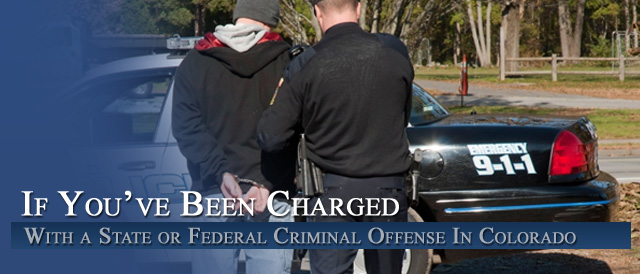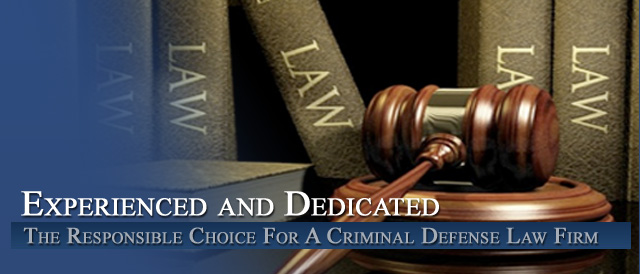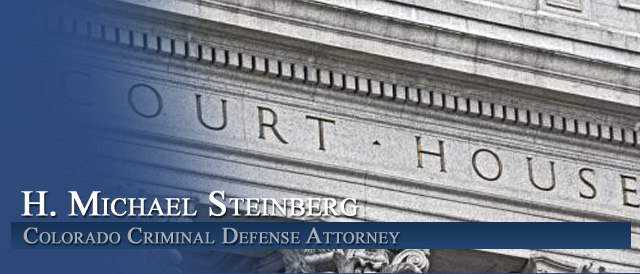




Understanding The Complex Colorado Crime of Reckless Endangerment C.R.S. 18-3-208
by H. Michael Steinberg – A Denver, Colorado Reckless Endangerment Attorney, C.R.S. 18-3-208
A person who recklessly engages in conduct which creates a substantial risk of serious bodily injury to another person commits Colorado Reckless Endangerment, which is a class-3 misdemeanor in our state. C.R.S. 18-3-208.
The definition of “recklessly” is: “A person acts recklessly when he consciously disregards a substantial and unjustifiable risk that a result will occur or that a circumstance exists.”
Every Crime is broken down into it’s elements – to prove this crime beyond a reasonable doubt – the District Attorney mut prove that:
1. The Defendant
2. Recklessly
3, Engaged in Conduct which created a Substantial Risk of Serious Bodily Injury
4. To Another Person
The focus on most defenses to this crime is defeating the mental state behind the act itself – that mental state is “Recklessly.” Sometimes that requires the testimony of an expert on the standard of care to be applied in a given example of someone’s conduct.
For example when it comes to the crime of manslaughter in Colorado:
Recklessness involves a higher level of culpability than criminal negligence, but requires less culpability than intentional actions. The State establishes a cause of action for reckless manslaughter when it proves the defendant caused the victim’s death and the defendant
Consciously disregarded a substantial and Unjustified risk that he would Cause the death of another.
The court may infer that the defendant was subjectively aware of the risk, However, the Court must weigh the nature and purpose of defendant’s conduct against the risk created by that conduct in evaluating whether a risk is unjustifiable. A substantial and unjustified risk is a gross deviation from the standard of care.
Risk of death to another in a general sense is sufficient; defendant need not risk death of a specific individual.
Compare this to Negligence
Contrasting recklessness with criminal negligence is helpful.
Both recklessness and negligence require a gross deviation from the standard of care, but recklessness requires subjective awareness of that risk while criminal negligence only requires a failure to perceive the risk.
In a 2000 case in Colorado that closely examined this standard in a skiing accident case – the Colorado Courts made clear – by analogy to a skier’s – Hall’s – actions – as to what “conscience disregard” really means – the description of the skier’s conduct is helpful:
….Hall’s conduct—skiing straight down a steep and bumpy slope, back on his skis, arms out to his sides, off-balance, being thrown from mogul to mogul, out of control for a considerable distance and period of time, and at such a high speed that the force of the impact between his ski and the victim’s head fractured the thickest part of the victim’s skull—created a substantial and unjustifiable risk of death to another person.
A reasonable person could infer that the defendant, a former ski racer trained in skier safety, consciously disregarded that risk. For the limited purposes of a preliminary hearing, the prosecution provided sufficient evidence to show probable cause that the defendant recklessly caused the victim’s death.
The most thorough analysis of the mental state of recklessness is found in the Hall case and is included here:
Manslaughter and Recklessness
We then examine the separate elements of recklessness, which require that an actor consciously disregard a substantial and unjustifiable risk that a result will occur or that a circumstance exists. See § 18-1-501(8).
Based on this review, we hold that to determine whether a risk is substantial and unjustified, a trier of fact must weigh the likelihood and potential magnitude of harm presented by the conduct and consider whether the conduct constitutes a gross deviation from the reasonable standard of care.
Whether a person consciously disregards such a risk may be inferred from either the actor’s subjective knowledge of the risk or from what a reasonable person with the actor’s knowledge and experience would have been aware of in the particular situation.
With the exception of strict liability crimes, a person is not subject to criminal sanctions unless the prosecution establishes that, in addition to committing a proscribed act, the person acted with the culpable mental state required for the particular crime.
In the past, courts and legislatures developed a variety of definitions for different mental states, creating confusion about what the prosecution had to prove in a criminal case. See Model Penal Code § 2.02, cmt. at 230 (1985) [hereinafter MPC].
Depending on the specific crime charged and the jurisdiction, juries might be instructed to determine whether the defendant acted with “‘felonious intent,’ ‘criminal intent,’ ‘malice aforethought,’ ‘guilty knowledge,’ ‘fraudulent intent,’ ‘willfulness,’ ‘scienter,’ . . . or ‘mens rea,’ to signify an evil purpose or mental culpability.” .
In addition to the variety of mental states required for different crimes, single crimes often referred to a number of different mental states, further complicating an analysis of culpability requirements. For example, Colorado’s statute, “Driving under influence——death,” stated:
Any person while under the influence of intoxicating liquor or of any exhilarating or stupefying drug, who causes the death of another by operating or driving any automobile, motorcycle, or other motor vehicle in a reckless, negligent, or careless manner, or with a wanton or reckless disregard of human life or safety, shall be deemed guilty of a felony and upon conviction shall be punished by imprisonment in the state penitentiary for a period of not less than one year nor more than fourteen years.
In order to eliminate the confusion created by this variety of ill-defined mental states, the Model Penal Code suggested that criminal codes articulate and define the specific culpable mental states that will suffice for criminal liability.
As part of a complete revision of Colorado’s criminal code in 1971, the General Assembly followed the Model Penal Code’s suggestion and adopted a provision specifically defining four culpable mental states:
“intentionally,” “knowingly,” “recklessly,” and “criminal negligence.”
The legislature adopted this section to define clearly the different levels of culpability that could be required for the commission of various offenses.
To be convicted of any crime other than a strict liability crime, a defendant must act with one of these four culpable mental states, depending on the statutory definition of each particular crime. If the elements for the required mental state are not satisfied, the defendant cannot be convicted of the crime charged.
To demonstrate that Hall committed the crime of manslaughter, the prosecution must provide sufficient evidence to show that the defendant’s conduct was reckless. § 18-3-104(1)(a).11 Thus, we focus on describing the mental state of recklessness and determining whether Hall’s conduct meets that definition.
Recklessness:
As Colorado’s criminal code defines recklessness, “A person acts recklessly when he consciously disregards a substantial and unjustifiable risk that a result will occur or a that circumstance exists.” § 18-1-501(8). Thus, in the case of manslaughter, the prosecution must show that the defendant’s conduct caused the death of another and that the defendant:
1) consciously disregarded
2) a substantial and
3) unjustifiable risk that he would
4) cause the death of another.
Substantial and Unjustifiable Risk
To show that a person acted recklessly, the prosecution must establish that the person’s conduct created a “substantial and unjustifiable” risk. The district court construed some of our earlier cases as requiring that the risk of death be “at least more likely than not” to constitute a substantial and unjustifiable risk of death. In interpreting our cases, the court relied on an erroneous definition of a “substantial and unjustifiable” risk.
Whether a risk is substantial must be determined by assessing both the likelihood that harm will occur and the magnitude of the harm should it occur. We hold that whether a risk is unjustifiable must be determined by assessing the nature and purpose of the actor’s conduct relative to how substantial the risk is. Finally, in order for conduct to be reckless, the risk must be of such a nature that its disregard constitutes a gross deviation from the standard of care that a reasonable person would exercise.
A risk does not have to be “more likely than not to occur” or “probable” in order to be substantial. A risk may be substantial even if the chance that the harm will occur is well below fifty percent. Thus there is reckless conduct where a defendant disregarded a risk that “any of the cars on the road” on a particular night might contain children)
Some risks may be substantial even if they carry a low degree of probability because the magnitude of the harm is potentially great. For example, if a person holds a revolver with a single bullet in one of the chambers, points the gun at another’s head and pulls the trigger, then the risk of death is substantial even though the odds that death will result are no better than one in six. As one court remarked,
If the potential of a risk is death, that risk is always serious. Therefore, only some likelihood that death will occur might create for most people a “substantial and unjustifiable” risk. . . .
Conversely, a relatively high probability that a very minor harm will occur probably does not involve a “substantial” risk. Thus, in order to determine whether a risk is substantial, the court must consider both the likelihood that harm will occur and the magnitude of potential harm, mindful that a risk may be “substantial” even if the odds of the harm occurring are lower than fifty percent.
Whether a risk is substantial is a matter of fact that will depend on the specific circumstances of each case. Some conduct almost always carries a substantial risk of death, such as engaging another person in a fight with a deadly weapon or firing a gun at another.
In the Colorado Case of Case v. People, 774 P.2d 866, 870 (Colo. 1989) a manslaughter conviction was upheld where defendant stabbed victim three times during a fight in another case a conviction of attempted reckless manslaughter where a defendant fired three shots at victim. In such instances, the substantiality of the risk may be evident from the nature of the defendant’s conduct and the court will not have to examine the specific facts in detail.
Other conduct requires a greater inquiry into the facts of the case to determine whether it creates a substantial risk of death. In Moore v. People, we affirmed a manslaughter conviction where the defendant kicked the victim to death. 925 P.2d 264, 269 (Colo. 1996). While “kicking another” may not necessarily involve a substantial risk of death, a trier of fact can find that repeatedly kicking the head and torso of someone already beaten unconscious can create a substantial risk of death.
Similarly, driving a car is not conduct that by its nature necessarily involves a substantial risk of death to others, but after viewing the facts of a particular case closely a court may determine that the defendant created a substantial risk of death. See, e.g., People v. Clary, 950 P.2d 654, 658-59 (Colo. App. 1997) (finding that driving a truck without adequate brakes constituted reckless conduct for vehicular homicide count).
A court cannot generically characterize the actor’s conduct (e.g., “driving a truck”) in a manner that ignores the specific elements of the conduct that create a risk (e.g., driving a truck with failing brakes on a highway). For example, “installing a heater” carries little risk under normal circumstances. However, the Connecticut Supreme Court held that improperly wiring a 120-volt heater to a 240-volt circuit, failing to use a lock nut to connect the heater to the circuit breaker, and using other faulty installation techniques creates a substantial risk of “catastrophic fire” and death.
Thus, to determine whether the conduct created a substantial risk of death, a court must inquire beyond the general nature of the defendant’s conduct and consider the specific conduct in which the defendant engaged.
As well as being substantial, a risk must be unjustifiable in order for a person’s conduct to be reckless. Whether a risk is justifiable is determined by weighing the nature and purpose of the actor’s conduct against the risk created by that conduct.
If a person consciously disregards a substantial risk of death but does so in order to advance an interest that justifies such a risk, the conduct is not reckless. For example, if a surgeon performs an operation on a patient that has a seventy-five percent chance of killing the patient, but the patient will certainly die without the operation, then the conduct is justified and thus not reckless even though the risk is substantial.
In addition to the separate analyses that are applied to determine whether a risk is both “substantial” and “unjustified,” the concept of a “substantial and unjustifiable risk” implies a risk that constitutes a gross deviation from the standard of care that a reasonable law-abiding person would exercise under the circumstances. Both the Model Penal Code and the New York Code, which the General Assembly followed in drafting the Colorado criminal code, expressly define a “substantial and unjustifiable risk” as one that is a gross deviation from the reasonable standard of care.
A substantial and unjustifiable risk must constitute a “gross deviation” from the reasonable standard of care in order to justify the criminal sanctions imposed for criminal negligence or reckless conduct, as opposed to the kind of deviation from the reasonable standard of care that results in civil liability for ordinary negligence. See Treiman, supra,at 337.12
Whether a risk is substantial and unjustified is a question of fact.
Conscious Disregard
In addition to showing that a person created a substantial and unjustifiable risk, the prosecution must demonstrate that the actor “consciously disregarded” the risk in order to prove that she acted recklessly. A person acts with a conscious disregard of the risk created by her conduct when she is aware of the risk and chooses to act despite that risk….. reckless conduct is a “conscious risk creation”).
In contrast to acting “intentionally” or “knowingly,” the actor does not have to intend the result or be “practically certain” that the result will occur, he only needs to be “aware” that the risk exists.
The statutory definitions of culpable mental states make these distinctions clear. A person acts ‘intentionally’ or ‘with intent’ when his conscious objective is to cause the specific result. . .
A person acts ‘knowingly’ or ‘willfully’ . . . when he is aware that his conduct is practically certain to cause the result.” “recklessness” is a conscious disregard of a substantial and unjustifiable risk.
Although recklessness is a less culpable mental state than intentionally or knowingly, it involves a higher level of culpability than criminal negligence. Criminal negligence requires that, “through a gross deviation from the standard of care that a reasonable person would exercise,” the actor fails to perceive a substantial and unjustifiable risk that a result will occur or a circumstance exists.
An actor is criminally negligent when he should have been aware of the risk but was not, while recklessness requires that the defendant actually be aware of the risk but disregard it.
Thus, even if she should be, a person who is not actually aware that her conduct creates a substantial and unjustifiable risk is not acting recklessly.
A court or trier of fact may infer a person’s subjective awareness of a risk from the particular facts of a case, including the person’s particular knowledge or expertise. Subjective awareness of the probability of consequences” often must be inferred from the defendant’s conduct and surrounding circumstances.
For example, a court may infer a person’s subjective awareness of the risks created by firing a gun from the facts that the person served an extended tour of duty in the military as a rifleman and machine gunner and was instructed by both the army and his father not to point a gun at another person. A court may infer from a person’s extensive training and safety instruction that the person understood the risks of fire and other “catastrophic dangers” created by the “slipshod” installation of a baseboard heater.
In addition to the actor’s knowledge and experience, a court may infer the actor’s subjective awareness of a risk from what a reasonable person would have understood under the circumstances.
When a court infers the defendant’s subjective awareness of a risk from what a reasonable person in the circumstances would have known, the court may consider the perspective of a reasonable person in the situation and with the knowledge and training of the actor. Although a court can infer what the defendant actually knew based on what a reasonable person would have known in the circumstances, a court must not confuse what a reasonable person would have known in the circumstances with what the defendant actually knew.
Thus, if a defendant engaged in conduct that a reasonable person would have understood as creating a substantial and unjustifiable risk of death, the court may infer that the defendant was subjectively aware of that risk, but the court cannot hold the defendant responsible if she were actually unaware of a risk that a reasonable person would have perceived.
Hence, in a reckless manslaughter case, the prosecution must prove that the defendant acted despite his subjective awareness of a substantial and unjustifiable risk of death from his conduct. Because absent an admission by the defendant such awareness cannot be proven directly, the court or trier of fact may infer the defendant’s awareness of the risk from circumstances such as the defendant’s training, knowledge, and prior experiences, or from what a reasonable person would have understood under the circumstances.
Risk of Death
The final element of recklessness requires that the actor consciously disregard a substantial and unjustifiable risk of a particular result, and in the case of manslaughter the actor must risk causing death to another person. The risk can be a risk of death to another generally; the actor does not have to risk death to a specific individual.
Other Articles of Interest:
- 005. COLORADO CRIMINAL CODE — OFFENSES AGAINST PERSONS – RECKLESS ENDANGERMENT
- Colorado Criminal Law – Attacking a Colorado Criminal Arrest Warrant – A “Franks” Challenge and Hearing To Dismiss The Charges
- Colorado Federal Criminal Cases
- Colorado Misdemeanor Vehicular Eluding – 42-4-1413 vs Felony Vehicular Eluding Cases – 18-9-116.5
- Colorado Criminal Law Guide – Your Lawyer’s Duty To You – The Client












